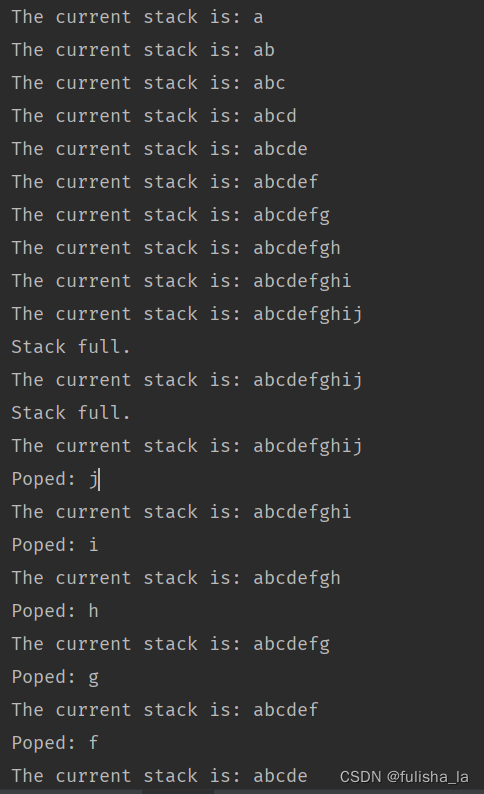日撸 Java 三百行day14-16
文章目录
- 说明
- day14 栈
- 1.栈的特点
- 2.代码
- day15 栈的应用-括号匹配
- 1.思路
- 2.代码
- day16 递归
- 1.递归特点
- 2.代码
说明
闵老师的文章链接: 日撸 Java 三百行(总述)_minfanphd的博客-CSDN博客
自己也把手敲的代码放在了github上维护:https://github.com/fulisha-ok/sampledata
day14 栈
1.栈的特点
栈:后进先出,只能在栈顶操作。是先移动“指针”还是先移动数据,在出栈和进栈时要保持一致。当进栈操作时,先将数据存入,“指针”再做加一操作;当出栈时,先将数据取出,“指针”再做减一操作。
2.代码
package datastructure.stack;
public class CharStack {
/**
* The max depth.
*/
public static final int MAX_DEPTH = 10;
/**
* The actual depth
*/
int depth;
/**
* The data
*/
char[] data;
/**
* Construct an empty char stack.
*/
public CharStack(){
depth = 0;
data = new char[MAX_DEPTH];
}
/**
* Overrides the method claimed in Object, the superclass of any class.
* @return
*/
@Override
public String toString(){
String resultString = "";
for (int i = 0; i < depth; i++){
resultString += data[i];
}
return resultString;
}
/**
* Push an element
* @param paraChar The given char.
* @return Success or not.
*/
public boolean push(char paraChar){
if (depth == MAX_DEPTH){
System.out.println("Stack full.");
return false;
}
data[depth++] = paraChar;
return true;
}
public char pop(){
if (depth == 0){
System.out.println("Nothing to pop.");
return '\0';
}
return data[--depth];
}
public static void main(String[] args) {
CharStack tempStack = new CharStack();
for (char ch = 'a'; ch < 'm'; ch++){
tempStack.push(ch);
System.out.println("The current stack is: " + tempStack);
}
char tempChar;
for (int i = 0; i < 12; i++){
tempChar = tempStack.pop();
System.out.println("Poped: " + tempChar);
System.out.println("The current stack is: " + tempStack);
}
}
}
运行结果

day15 栈的应用-括号匹配
1.思路
- 任务描述: 检查一个字符串的括号是否匹配. 所谓匹配, 是指每个左括号有相应的一个右括号与之对应, 且左括号不可以出现在右括号右边. 可以修改测试字符串, 检查不同情况下的运行.
- 思路:如(),[],{}括号左右对称,我们将括号分为左右,左括号入栈(遇到其他字符直接跳过不处理),遇到右括号就出栈一个左括号与之匹配,匹配成功即匹配,失败则不匹配。不要忘记在最后要判断一下栈中括号是否出栈完。在这里使用的是switch…case来进行判断分支,但是若换成if,else if,else来实现,则代码中会出现很多的分支,显然会显得代码很冗余,所以当分支较多时,使用switch相比if会好一些。
2.代码
/**
* Is the bracket matching?
* @param paraString The given expression.
* @return Match or not.
*/
public static boolean bracketMatching(String paraString){
//step1 Initialize the stack through pushing a '#' at the bottom.
CharStack tempStack = new CharStack();
tempStack.push('#');
char tempChar, tempPopChar;
//step2 Process the string. For a string, length() is a method instead of a member variable.
for (int i = 0; i < paraString.length(); i++){
tempChar = paraString.charAt(i);
switch (tempChar){
case '(':
case '[':
case '{':
tempStack.push(tempChar);
break;
case ')':
tempPopChar = tempStack.pop();
if (tempPopChar != '('){
return false;
}
break;
case ']':
tempPopChar = tempStack.pop();
if (tempPopChar != '['){
return false;
}
break;
case '}':
tempPopChar = tempStack.pop();
if (tempPopChar != '{'){
return false;
}
break;
default:
//do nothing
}
}
tempPopChar = tempStack.pop();
if (tempPopChar != '#'){
return false;
}
return true;
}

day16 递归
1.递归特点
- 理解:自己调用自己的方法,但是不能无限制的调用,在合适的时候又要一层层跳出自己方法最后跳出。在使用递归时,我觉得不能把问题考虑的太细,不然会陷入这个循环中把自己给绕晕,既然每个子问题规律一样,只需要知道他们规律,剩下交给计算机处理。在递归过程中,一定要保证有跳出递归的条件还有就是递归函数不一定效率就很高,如会受递归的深度、递归函数的实现方式等影响。当递归深度较大时,可能会导致堆栈溢出,从而影响程序的性能。
2.代码
- 递归实现1到n的和
如果n小于0,则返回0作为结果。
如果n大于0,则递归调用函数,并返回n加上递归调用函数的结果。 - 斐波那契数列
F(0) = 0
F(1) = 1
F(n) = F(n-1) + F(n-2) (n >= 2)
package datastructure.stack;
public class Recursion {
/**
* Sum to N. No loop, however a stack is used.
* @param paraN
* @return
*/
public static int sumToN(int paraN){
if (paraN<0){
return 0;
}
return sumToN(paraN-1) + paraN;
}
/**
* Fibonacci sequence.
* @param paraN The given value.
* @return The sum.
*/
public static int fibonacci(int paraN){
if (paraN <= 0){
return 0;
}else if(paraN == 1){
return 1;
}
return fibonacci(paraN-1) + fibonacci(paraN-2);
}
public static void main(String[] args) {
int tempValue = 5;
System.out.println("0 sum to " + tempValue + " = " + sumToN(tempValue));
tempValue = -1;
System.out.println("0 sum to " + tempValue + " = " + sumToN(tempValue));
for(int i = 0; i < 10; i ++) {
System.out.println("Fibonacci " + i + ": " + fibonacci(i));
}
}
}

